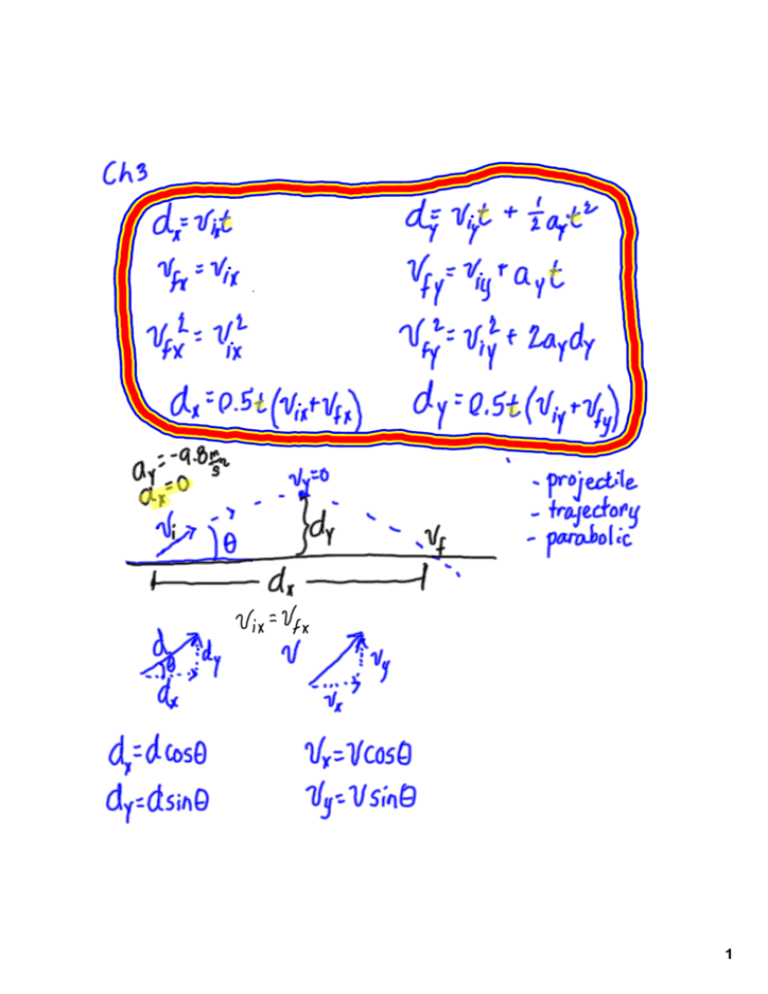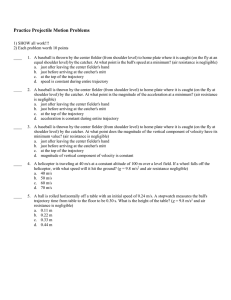Untitled
advertisement

1 Pre­Engineering Physics Chapter 3­Velocity Vectors 1. A baseball is thrown by the center fielder (from shoulder level) to home plate where it is caught (on the fly at an equal shoulder level) by the catcher. At what point is the ball’s speed at a minimum? (air resistance is negligible) Diagram for #1,2,3 a. just after leaving the center fielder’s hand b. just before arriving at the catcher’s mitt c. at the top of the trajectory d. speed is constant during entire trajectory 2. A baseball is thrown by the center fielder (from shoulder level) to home plate where it is caught (on the fly at shoulder level) by the catcher. At what point is the magnitude of the acceleration at a minimum? (air resistance is negligible) a. just after leaving center fielder’s hand b. just before arriving at catcher’s mitt c. at the top of the trajectory d. acceleration is constant during entire trajectory 3. A baseball is thrown by the center fielder (from shoulder level) to home plate where it is caught (on the fly at shoulder level) by the catcher. At what point does the magnitude of the vertical component of velocity have its minimum value? (air resistance is negligible) a. just after leaving center fielder’s hand b. just before arriving at catcher’s mitt c. at the top of the trajectory d. magnitude of vertical component of velocity is constant 4. John throws a baseball from the outfield from shoulder height, at an initial velocity of 29.4 m/s at an initial angle of 30.0° with respect to the horizontal. The ball is in its trajectory for a total interval of 3.00 s before the third baseman catches it at an equal shoulder­height level. (Assume air resistance negligible.) What is the ball’s horizontal displacement? Diagram for #4,5,6 a. 76.4 m b. 38.2 m c. 57.3 m d. zero 5. A baseball thrown from the outfield is released from shoulder height at an initial velocity of 29.4 m/s at an initial angle of 30.0° with respect to the horizontal. If it is in its trajectory for a total of 3.00 s before being caught by the third baseman at an equal shoulder­height level, what is the ball’s net vertical displacement during its 3­s trajectory? a. 11.0 m b. 9.80 m c. 22.1 m d. zero 6. A baseball thrown from the outfield is released from shoulder height at an initial velocity of 29.4 m/s at an initial angle of 30.0° with respect to the horizontal. What is the maximum vertical displacement that the ball reaches during its trajectory? a. 11.0 m b. 9.80 m c. 22.1 m d. zero 2 3 7 . A stone is thrown with an initial speed of 15 m/s at an angle of 53° above the horizontal from the top of a 35 m building. If g = 9.8 m/s and air resistance is negligible, then what is the magnitude of the vertical velocity­component of the rock as it hits the ground? Diagram for #7,8,9,10 a. 9.0 m/s b. 18 m/s c. 26 m/s d. 29 m/s 8. A stone is thrown with an initial speed of 15 m/s at an angle of 53° above the horizontal from the top of a 35 m building. If g = 9.8 m/s2 and air resistance is negligible, then what is the magnitude of the horizontal component of velocity as the rock strikes the ground? a. 7.5 m/s b. 9.0 m/s c. 12 m/s d. 29 m/s 9. A stone is thrown with an initial speed of 15 m/s at an angle of 53° above the horizontal from the top of a 35 m building. If g = 9.8 m/s2 and air resistance is negligible, then what is the speed of the rock as it hits the ground? a. 15 m/s b. 21 m/s c. 30 m/s d. 36 m/s 10. A stone is thrown with an initial speed of 15 m/s at an angle of 53° above the horizontal from the top of a 35 m building. If g = 9.8 m/s and air resistance is negligible, what is the magnitude of the horizontal displacement of the rock? a. 38 m b. 46 m c. 66 m d. 90 m 11. A rifle is aimed horizontally toward the center of a target 100 m away. If the bullet strikes 10 cm below the center, what was the velocity of the bullet? (Ignore air friction.) a. 300 m/s b. 333 m/s c. 500 m/s d. 700 m/s 12. Two projectiles are launched at 100 m/s, the angle of elevation for the first being 30° and for the second 60°. Which of the following statements is false? a. Both projectiles have the same acceleration while in flight. b. The first projectile has the lower speed at maximum altitude. c. Both projectiles have the same range. d. All of the above statements are false. 4 5










